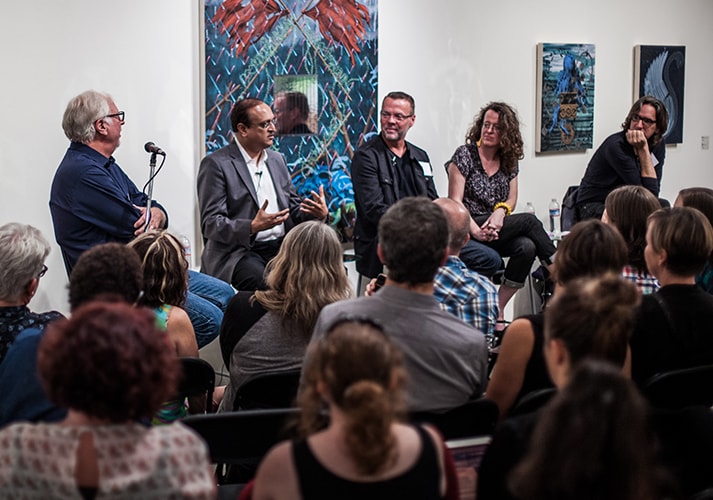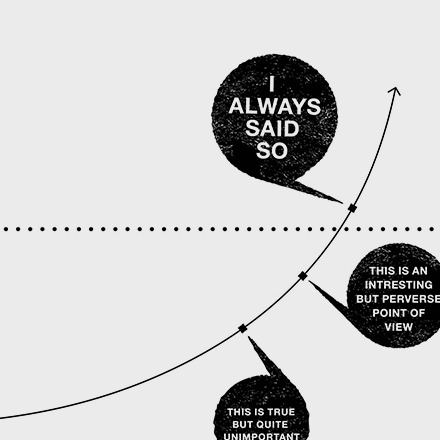Does success destroy innovation? Mohan Nair explains.
How can you make innovation come alive in your organization? “The courage that comes from within—belief and confidence even in the line of possible failure—is what makes an innovator different,” says Mohan Nair. The author of Strategic Business Transformation (Wiley, 2011) and Chief Innovation Officer at Cambia Health Solutions, he recently joined Liquid Agency for a panel discussion at Design Week PDX. In Part Two of his conversation with writer Tiffany Lee Brown, Mohan talks about nurturing innovation in others and preparing yourself for change. He also says that large organizations can be just as agile as smaller ones—and that success can destroy innovation.
An interview with Mohan Nair (part two).
T: Tell us a little more about how innovation works in your job.
M: I run an accelerator inside this large institution. My job is to be the lightning rod of innovation, to exercise and accelerate ideas across the company. We have statistics to prove that we have driven that to a level that is benchmarkable by most world-class companies.
And of course my job at Cambia as Innovation Officer is to bring out the conditions whereby we can play at our highest level, right? You and I know healthcare needs innovation but we kind of lost our way in some ways and we’ve lost our identity in the healthcare system. We let the system take over.
Innovation is the agent of transformation. It’s the activity you use, when you’re innovating, you’re using the tools to transform your business. I think innovation is the map to bring us back to what we should be doing and why, in healthcare.
T: You’re dealing with a lot of large organizations, from research facilities to government agencies, from hospitals to insurance companies… whereas a small Silicon Valley startup or a local art collective has the luxury to be quite nimble with innovating. Isn’t it easier to move a little boat than a giant ship?
M: Cambia is a collection of portfolios, 22 different organization ranging from large health insurers holding the Blue Cross/Blue Shield name, in four different parts of Oregon, Idaho, Utah, and Washington—and then several other companies that range from a $100 million company to a small, two-person startup. So we have that range in our portfolio. But eleven years ago, when I joined up, we were a fully directed insurance body. Yes, some elements ran slow because the business required so much regulatory understanding, and the life cycles were long for products. People found a natural beat to where they were going. They were not slow people; they were people working to the pace of the market. We all—me and my boss and everybody who hired me—anticipated that the market would shift, and they wanted to be a catalyst for that transformation.
So I got brought in to help transform Cambia into an agile, innovative, respectful company, respectful of the monies that were delivered to us for health, in a not-for-profit way. I’ll tell you, the assumption now that I hear, where big is slow and small is fast is not as clear to me now as it was then. The market has moved, it’s getting more and more complex, and more diverse in its solutions. The rate of change is 2x every two years, which mimics the chip cycle, the high tech cycle in Moore’s Law, we are seeing tremendous acceleration in the market. We were prepared for it, but even prepared for it we were challenged.
I feel that you can transform large organizations to become agile organizations—and we have done it. There is a secret sauce, or many secret sauces, you can add to make that happen. I have been witness to that in my own company.
I have enjoyed it and I have worked on it with people smarter than me. I have seen true transformation from the inside out. However, I believe that it is “inside-out.” That to change, Gandhi always said, “Be the change you wish to see in the world.” And we took that to heart and we transformed ourselves and our attitude before we attempted to transform the market and the members. That gave us the basis to build an agile and innovative culture, one that handles compliance with a degree of rule-following but with a degree of intelligence, not just blind following.
T: When you’ve come up with an innovation that you think has promise, or you’re advocating for someone else’s innovative idea, what obstacles do you run into most frequently? And what do you do about them?
M: My job is not to be the idea guy—I’m the support-the-people-with-the-ideas guy, right? Even though I can always bring my idea into the game, and start companies or build organizations or define new products—I know we have it in our team. It is more important that we move innovation from being an objective to being a value within the organization. You see, if you don’t set up innovation the right way, in a large organization, it will fail. Innovation should be the right and responsibility of everybody in the company.
T: So how does that work?
M: You’ve got a bunch of people who are used to doing work a certain way, who get rewarded to do it a certain way, and they want to eliminate anything considered waste, and they want to eliminate anything that de-focuses them. Because they’re operationally inclined to produce to meet their performance measures.
The very thing that makes the company successful destroys innovation. When things are undefined, it’s the enemy of the operational team. They don’t like it. Standard operating processes like to kill any new egg, because it stops the line from moving where it has to go. We in this innovation role have to break that habit. We have to allow for people stop and literally smell a rose, because it might actually create a scent for them, for a different direction.
That’s the skill; it’s about nurturing ideas and nurturing people with ideas, and training leaders to understand that it is not an enemy to stop and think. It’s not all about “do.”
T: What prevents an organization from nurturing people’s innovative ideas?
M: What stops innovation? The power of the inertia of the operational success. What destroys a company is its success of doing what it’s doing now—in a changing market.
So how do you change that? You impact people with training, measure them a different way, and give them the room to engage in ideas. And remind everyone that the predictable business model today could be the obsolete business model tomorrow, and that you have to have ambidexterity when you’re a leader. As a leader of an organization, or anyone in the organization leading, you have to incrementally innovate as well as disruptively innovate. You incrementally innovate what you’re doing now, but you disruptively innovate by asking the question, “Why do I do what I’m doing now?” And it has to be done simultaneously.
You train them to do that—and that’s not easy, but that’s the real thing that gets things going.
T: Have you overseen training programs hands-on?
M: Yes. For the last two years we’ve done workshops which we have tried inside and outside the company, we have generated ideas, we have walked those ideas through, we have shown it by example, we have built companies. We have done any of those considerations to wake up the creativity of our organization. And they have responded.
T: Does this apply across the hierarchy of employees within the companies that you work with, as well as in your organization? Do you have a place for ideas at different levels?
M: When it comes to ideas, we don’t have hierarchy.
T: So if the janitor wants to talk to you about an idea, how does that work?
M: Great. We try to think of ideas. We coach everyone at any time. We are about coaching the person, not the idea. The idea is less important than the person. Because we’re not in the business of ideas. If we were in the business of ideas, we’d just get an idea engine going and just keep sucking out ideas. [Laughter]
But we’re in the business of transforming culture, from a compliance-oriented culture to an intelligently compliant company that has inventive, innovative ideas. That’s about people.
T: We’ve talked about inertia and active resistance to change. Innovation means change, and change usually means sacrifice. In order to have room for something new, we have to let go of something old. This process can be especially difficult for people who already have a lot to lose—including large corporations, successful individuals who are raising families, small entrepreneurs who’ve gotten a foothold in a new market. We end up with fear-based inertia. How would you recommend that people prepare themselves psychologically and emotionally for truly innovative change, not just in business but in their lives?
M: You know, I wish I was a good example of what I say. And you can quote me on that.
T: I will.
M: Because I am humbled by soundbytes that have no meaning—I cannot tell other people how to live their ways, and how they can adapt to the hardships and challenges they face. I face them myself. I’m in transition many times in my life; I don’t have a stable, stoic life. I have changes going on all the time. And I am one step away, or three decisions away, from being on the street, every day of my life.
But if I live every day on that belief—then I am heading there. If I live on the belief that I am one idea away from serving others remarkably, or doing something that no one else has done before, in the hopes of finding my legacy or destiny, then I have a different attitude.
It starts with perspective, I guess. What I’ve learned from the great leaders of our times is that they are willing to sacrifice that which they had considered sacred in their lives for a purpose greater than themselves. It is a very expensive proposition; it is a costly thing, to be an innovator, because you have to sacrifice things. Choices have to be made that could destroy your life and the lives of others in the course of your action. And it is something to be really taken with a great deal of respect and authority and understanding.
You don’t just do things when lives are involved, in the whim and the fancy of classic entrepreneurial rigor and vigor. When you deal with subjects like healthcare, education, energy, and the way we protect our country… We also have to understand that change and transformation is painful. It is never easy. And we have to adapt to it and accept it, and that is tough. It is not easily dealt with. However, if you believe that fear is what drives you, then fear will consume you. It’s an easy step from being consumed to being destroyed.
I believe that the courage that comes from within—belief and confidence even in the line of possible failure—is what makes an innovator different.
T: What a great statement. This has been a great conversation! I have one last question: if you could implement one innovation in the healthcare system, what would you start out with?
M: If there’s one thing I could change about the healthcare system, it would be to affect the mindset of all the population that deals with the healthcare system, that they are and will be the center of the healthcare system—not the system itself at the center. Right now the system is institutionalized to perpetuate itself, and the lens has to change towards consumer-centered behaviors. The system has to adjust for the consumer.
Just as we share the road when we come to work, we have to share the highway for health. That doesn’t mean that you get a special lane for you, or you demand something that you pay for and you get it. It means were all on the same road, with an understanding that when you use one part of the road, other people can’t use it. There is a limited and scarce resource of care, and we have to be custodians of each other. When someone stalls on the road, someone stops and helps that person. And if we don’t help that person, everybody else will be stuck on that road. Right now we’re in a traffic jam.
T: What a wonderful metaphor.
M: Most people don’t get that. With healthcare, they think, “It’s my road, it’s my highway, I’m paying, so I deserve something and I wanna be in the front.” Well, we all pay so that one of us can be healed when the time comes. We all pool our monies and help together. We all keep our cars able to handle the road because we don’t want to block anybody else from going to where they go.
And we don’t want to get stuck either. It’s all mutually in favor of a pathway. Responsible usage of healthcare and consumer expectation of care, and the driving down of prices, and the driving up of value. And the consumer is at the center, not the insurance company. That’s the one thing I would ask for.
Recap of Part One interview with Mohan Nair.
In PART ONE, Mohan described how Mother Teresa was a better entrepreneur than Steve Jobs, creativity is subordinate to innovation, and the old, narcissistic principles of business will destroy you. Read it here: A Cause Greater Than Yourself—Mohan Nair on Innovation
And see the video (below) of Mohan Nair with moderator Marty Neumeier and panelists Genevieve Bell, Jeff Faulkner, and Michael Shea at Liquid Agency’s “What Sparks Innovation?” discussion.


